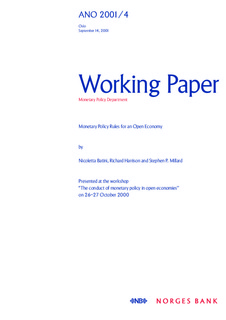| dc.contributor.author | Batini, Nicoletta | |
| dc.contributor.author | Harrison, Richard | |
| dc.contributor.author | Millard, Stephen P. | |
| dc.date.accessioned | 2018-05-22T11:52:34Z | |
| dc.date.available | 2018-05-22T11:52:34Z | |
| dc.date.issued | 2001 | |
| dc.identifier.isbn | 82-7553-180-2 | |
| dc.identifier.issn | 0801-2504 | |
| dc.identifier.uri | http://hdl.handle.net/11250/2498713 | |
| dc.description | Presented at the workshop ‘’The conduct of monetary policy in open economies’’ on 26–27 October 2000 | nb_NO |
| dc.description.abstract | The most popular simple rules for the interest rate, due to Taylor (1993a) and Henderson and McKibbin (1993), are both meant to inform monetary policy in economies that are closed. On the other hand, their main open economy alternative, i.e. Ball’s (1999) rule based on a Monetary Conditions Index (MCI), may perform poorly in the face of specific types of exchange rate shocks and thus cannot offer guidance for the day-to-day conduct of monetary policy. In this paper we specify and evaluate a comprehensive set of simple monetary policy rules that are suitable for small open economies in general, and for the UK in particular. We do so by examining the performance of a battery of simple rules, including the familiar Taylor and Henderson and McKibbin rules and MCI-based rules à la Ball. This entails comparing the asymptotic properties of a two-sector open-economy dynamic stochastic general equilibrium model calibrated on UK data under different rules. We find that an inflation forecast based rule (‘IFB’), i.e. a rule that reacts to deviations of expected inflation from target is a good simple rule in this respect, when the horizon is adequately chosen. Adding a separate response to the level of the real exchange rate (contemporaneous and lagged) appears to reduce the difference in adjustment between output gaps in the two sectors of the economy, but this improvement is only marginal. Importantly, an IFB rule, with or without exchange rate adjustment, appears robust to different shocks, contrary to naïve or Ball’s MCIbased rules. | nb_NO |
| dc.language.iso | eng | nb_NO |
| dc.publisher | Norges Bank | nb_NO |
| dc.relation.ispartofseries | Working Papers;4/2001 | |
| dc.rights | Attribution-NonCommercial-NoDerivatives 4.0 Internasjonal | * |
| dc.rights.uri | http://creativecommons.org/licenses/by-nc-nd/4.0/deed.no | * |
| dc.subject | open economy | nb_NO |
| dc.subject | dynamic equilibrium model | nb_NO |
| dc.subject | monetary policy rules | nb_NO |
| dc.title | Monetary Policy Rules for an Open Economy | nb_NO |
| dc.type | Working paper | nb_NO |
| dc.description.version | updatedVersion | nb_NO |
| dc.subject.nsi | VDP::Samfunnsvitenskap: 200::Økonomi: 210::Samfunnsøkonomi: 212 | nb_NO |
| dc.source.pagenumber | 43 | nb_NO |

